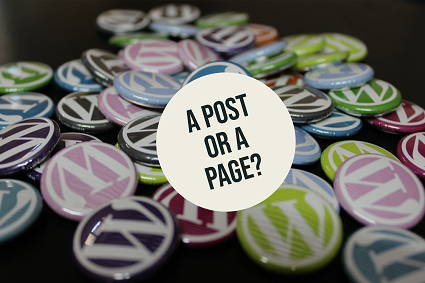Your cart is currently empty!

A Post or a Page?
WordPress websites give you the option of creating a Post or a Page.
Here’s the editor for a Post:

Here’s the editor for a Page:

No wonder people get confused!
Pages
Notice that the Page editor gives you the chance to specify a Parent page. Pages are naturally good for hierarchical organization. When you have three locations and each one has a page, you can organize your location pages under Locations.
Pages don’t use Categories and Tags, as posts do. You can’t include pages and posts together under a category, for example. If you want to have a category people can browse through to learn about mental health, you should not use pages for that content.
Pages also don’t show up in RSS feeds. If you encourage people to subscribe to your feed, remember that your pages won’t be included in that feed.
Pages are perfect for timeless content. Your About Us page, your Contact page, your Services page — these will be updated as time goes on, but they are permanent, not temporary. Most of the tabs in your website’s navigation should go to Pages.
Pages are also the right choice for sales pages and landing pages for ads. They stand on their own and don’t have to fit in with your chronological stream of posts.
Posts
Posts can’t be arranged in a hierarchy. They can be sorted out by Tags and Categories. Depending how your website is built, this can be the most important difference between the two.
Posts, whether you use them for blogging or not, show up in chronological order. This makes them perfect for news stories and things that change or are seasonal or temporary in nature.
They show up in your RSS feed, too.
Just as your Contact Us information is permanent and should be on a Page, your Reader’s Choice Award is news and should be in a Post.
Custom Post Types
The editor screen for a Post at the top of this page is showing the place where you create an ordinary Post — a blog post, a news article, etc.
But your website might also use special posts for Products, Events, Team Members, or other kinds of information. These usually will be pulled to a special page with all your products, events, and so forth.
The Events page shown below is an example. Each Event is put in as a special type of Post. All the events are pulled to the Events Page. They are shown in chronological order. As each event takes place, it goes off of the page, so that only upcoming events are shown.

Most shopping carts pull products into a page in the same way. Team pages, portfolio pages, and real estate listings like the page shown below can also work this way.

Post/ Page combinations
While Custom Post Types are often used to create dynamic Pages, you can also use Categories to create Pages. If you have Posts on various topics and those are the natural navigation for your website, you can make Pages that pull in Posts with specific Categories.
The screenshot below shows a website built in this way, with Categories of Posts creating the navigation.

You can mix Categories of Posts with Pages in your menu.
Decision time
To a large extent, the decision to make a Post or a Page depends on your intentions for the content you’re creating, and the way you want your visitor to experience the content.
We often build website to use Categories and Custom Post Types in specific ways. This settles the question of when to use Posts and Pages in many cases.
What you want to avoid is random use of the two. If you build a Page for a fundraising event today and make a Post for the next fundraising event, you will limit the way that you can use the content you’ve made. You’ll also make it hard to find the information.
You might choose to build a landing page for each event, to use Custom Post Types to add events to your calendar or Events Page, and also to write multiple Posts about each event as news stories. Just be consistent in the way you use Posts and Pages. Make a decision — bring in your web team for best results — and stick with it.
by
Tags:

Leave a Reply